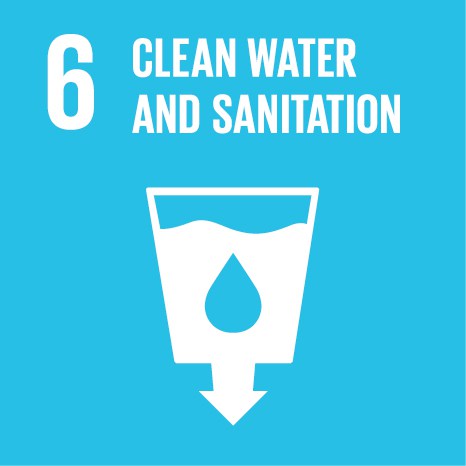4.2) By 2030, ensure that all girls and boys have access to quality early childhood development, care and pre-primary education so that they are ready for primary education
PPL Corporation supports low-income student programs and increased pre-school education, especially in areas of science, technology, engineering, and math (STEM). For example, in Pennsylvania PPL engages in a state grant program that provides scholarships for low-income children to attend excellent preschools. PPL invests over $2 million each year to support educational programs like this in communities across the country.
6.4) By 2030, substantially increase water-use efficiency across all sectors and ensure sustainable withdrawals and supply of freshwater to address water scarcity and substantially reduce the number of people suffering from water scarcity
PPL continues to manage its water use in an efficient way and monitor the impact of wastewater discharged into waterways. None of their water is sourced from regions with “high or extremely high baseline water stress.” All but one of the power plants owned by LG&E and KU Energy, a subsidiary of PPL Corporation, are located near the Ohio River, which is not adversely affected by droughts.
Additionally, PPL is decreasing water use and increasing power plant efficiency at their remaining coal-fired power plants in Kentucky.
7.1) By 2030, ensure universal access to affordable, reliable, and modern energy services
PPL’s utilities continuously review operations to improve efficiency and control costs, while also focusing on providing affordable, reliable, safe and environmentally responsible energy to their customers. PPL’s monitoring helps keep its energy rates cheaper than average for customers in the mid-Atlantic region. The company has set a goal to reduce the existing operating and maintenance expenses, further ensuring access to affordable energy.
7.2) By 2030, increase substantially the share of renewable energy in the global energy mix
PPL’s operating company LG&E and KU, make investments in expanding renewable and distributed resources, as well as researching low-carbon technologies. LG&E and KU recently built Kentucky’s largest utility-scale solar photovoltaic facility at E.W. Brown Generating Station, featuring more than 45,000 solar panels on approximately 50 acres. The company also offered a Green Tariff to further support renewable energy growth and economic development in Kentucky.
PPL offers a Solar Share program, which gives residential, business, and industrial customers the opportunity to share in local solar energy and receive credits on their monthly bills. In Kentucky, PPL collaborates with the Electric Power Research Institute on energy storage research. The company also works with demonstration sites, allowing the utilities to develop, test, and evaluate the potential benefits and operating needs of large-scale battery technologies.
In Pennsylvania, PPL Electric has developed and implemented an advanced Distributed Energy Resource Management System designed to manage solar, wind, and other renewable power coming onto the grid, which helps ensure quality and reliable power, while keeping the grid running smoothly.
7.3) By 2030, double the global rate of improvement in energy efficiency
In addition to distributing critical energy-efficient information to their customers, PPL has implemented energy efficiency programs across their utilities—saving more than 307,000 megawatt-hours of electricity. These tools and programs include free online energy assessments and free energy efficiency kits, including energy-saving products. PPL company LG&E and KU also offers demand conservation programs for their customers, which incentivizes bill credits in exchange for the installation of demand conservation devices. This program allows for reduced energy consumption on peak usage summer days.
8.2) Achieve higher levels of economic productivity through diversification, technological upgrading and innovation, including through a focus on high-value added and labor intensive sectors
PPL Corporation invests in technology and partnerships to help the U.S. electricity sector achieve carbon neutrality by 2050. In their mission to achieve this, PPL has joined Energy Impact Partners’ global investment platform, which brings together leading global companies and entrepreneurs to foster innovation toward a sustainable energy future. PPL will invest up to $50 million to this program to help accelerate the shift to a low-carbon energy system and implement commercial-scale solutions that are needed for an economy-wide decarbonization. PPL is an anchor sponsor of the collaboration between the Electric Power Research Institute and the Gas Technology Institute, aimed at conducting intensive and focused R&D in clean energy technologies.
PPL Electric Utilities supports collaborative, industry-wide research, spearheaded by the National Electric Energy Testing, Research and Application Center, including reliability analysis, power cable system design, and distribution system standards.
PPL company LG&E and KU have recently worked with the University of Kentucky on a megawatt-scale carbon capture pilot and are now collaborating with the Electric Power Research Institute on a large-scale energy storage project.
Lastly, PPL provides incentives to support economic development efforts like LG&E and KU’s Economic Development Rider—an incentive rate for existing industry expansions, new project locations, and redevelopment initiatives. PPL is committed to empowering communities through charitable funding worth millions of dollars and partnering with local communities for economic development, disaster readiness, and emergency preparedness.
8.3) Promote development-oriented policies that support productive activities, decent job creation, entrepreneurship, creativity and innovation, and encourage formalization and growth of micro-, small- and medium-sized enterprises, including through access to financial resources
Since the 1920s, PPL has worked with its network of partners to locate hundreds of companies and thousands of jobs with attention to meeting local economic development needs. Most recently, PPL has played an integral role in the urban revitalization of Downtown Allentown, Pennsylvania, working alongside a coalition of business, community, and government partners to enable more than $1 billion in commercial development and the creation of 3,000 jobs.
Since 2000, PPL Companies LG&E and KU have helped create nearly 110,000 new jobs in Kentucky. The companies’ Economic Development team were honored by Site Selection Magazine for helping Kentucky create more than 80% of the 12,500 new jobs created in the state in 2013. In addition, LG&E and KU have created approximately 3,200 construction jobs across the country as part of its ongoing $6 billion investment environmental upgrade projects.
9.4) By 2030, upgrade infrastructure and retrofit industries to make them sustainable, with increased resource-use efficiency and greater adoption of clean and environmentally sound technologies and industrial processes, with all countries taking action in accordance with their respective capabilities
PPL has taken on many recent projects to enable renewable and sustainable energy sources within their systems. In 2020, PPL invested over $3 billion in infrastructure improvements and projects that strengthen reliability, make the grid smarter, and ensure the flexibility needed for future renewable energy resources. PPL’s utilities are routinely monitoring and maintaining their systems, installing advanced metering infrastructure, updating aging power lines and substations, building new substations, and incorporating advanced technology.
13.2) Integrate climate change adaptation and mitigation into national policies, strategies and planning
PPL Corporation has set a goal to achieve net-zero carbon emissions by 2050. In addition, we are targeting a 70% reduction from 2010 levels by 2035 and an 80% reduction by 2040.
PPL has already cut their carbon emissions by nearly 60% since 2010 by phasing out coal-fired generation in Kentucky and investing over $30 billion in the past decade in research and development. This investment will strengthen grid resilience in the face of future storms, reduce power plant emissions, and prepare networks to better integrate more distributed energy resources.











